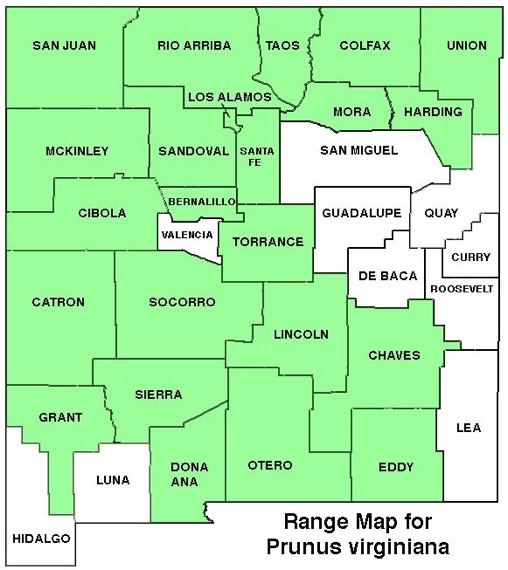WILDFLOWERS OF NEW MEXICO

Elliptical, bright-green leaves with 6–18 lateral veins cover the thornless, bushy shrubs to small trees that can reach 25 feet tall, often with thicket-forming root shoots. Note the dense, elongated clusters of small white flowers, and the dark red to black berries loved by birds and bears.
FLOWERS: April–June. Blooms after leaves emerge. Dense, elongated clusters 1 5/8–8 inches long (4–20 cm) have 18–64 flowers, each 3/8–3/4 inch wide (1-2 cm) with 5 petals, many stamens. Fruit are drupes, 1/4–1/2 inch diameter (6-8 mm), juicy, maturing dark red to black. Note the pointed calyx (sepal) lobes fall off the fruit long before maturity leaving only a smooth collar at the base.
LEAVES: Alternate, stalked; blades elliptic to oval, 1–4 3/4 inches long (2.5–12 cm); edges with shallow, teeth rounded to serrated, spreading out from leaf edge; top surface bright green, bottom smooth to short-hairy, lateral veins 6–18 per side, raised on bottom; tip pointed to blunt.
HABITAT: Open woods, slopes, canyon bottoms, riparian areas, disturbed areas; pinyon-juniper-oak foothills, ponderosa pine-Douglas fir, aspen forests.
ELEVATION: 5,500–9,050 feet (1700–2760 m).
RANGE: Widespread in every western state and throughout most of the United States and Canada.
SIMILAR SPECIES: Black Cherry, P. serotina, can be distinguished by carefully examining the leaves noting the incurved teeth and 15–30 lateral veins per side, smooth (not raised) on the bottom; maturing fruit has pointed, reddish calix (sepal) lobes at base of fruit. American Plum, P. americana, widespread and possibly introduced and naturalized, is thorny, thicket forming, and has bundles of 2–5 flowers that bloom before leaves emerge.
NM COUNTIES: Widespread across NM in mid-elevation, moist to dry habitats: Bernalillo, Catron, Chaves, Cibola, Colfax, Eddy, Grant, Harding, Lincoln, McKinley, Moro, Otero, Rio Arriba, San Juan, Sandoval, Sierra, Socorro, Taos, Torrance, Union.









WESTERN CHOKECHERRY
PRUNUS VIRGINIANA VAR. DEMISA
Rose Family, Rosaceae
Deciduous shrub to small tree



























THE CONTENTS OF THIS WEBSITE ARE COPYRIGHTED AND CANNOT BE USED
WITHOUT PERMISSION OF GEORGE OXFORD MILLER
















EMAIL ME









Leaves have 6–18 lateral veins (top arrow) and teeth that spread away from the edges (bottom arrow).



Fruit matures from red to blackish. Note the points of the sepals at the base of the drupe fall off leaving a round collar (arrow).
Chokecherries and other Prunus species provide a rich source of nectar and a host plant for butterflies and their caterpillars, and the fruit feeds birds, bears, and small mammals.

























